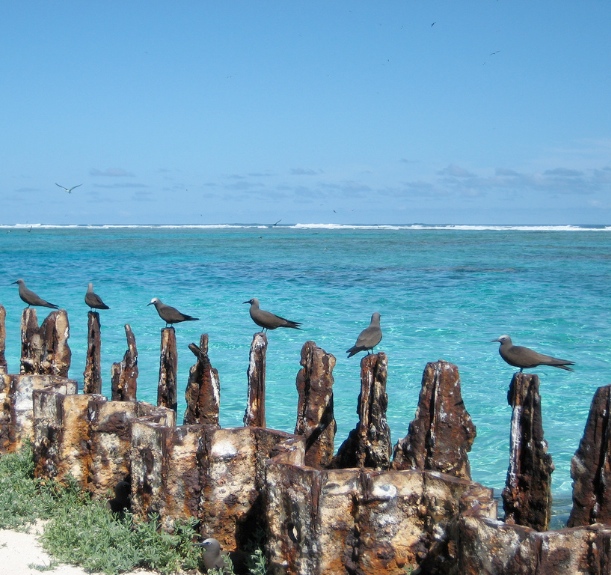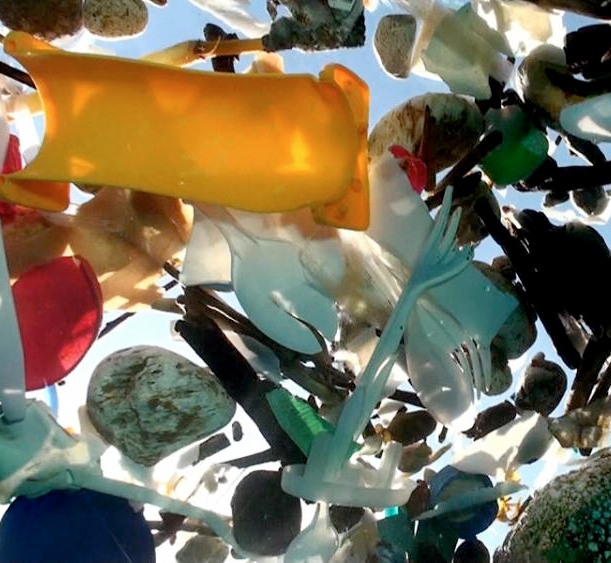Warming, Rising Acidity and Pollution: Top Threats to the Ocean
Since the last World Oceans Day, we’ve documented trash in the deep sea, sea snails with acid-weakened shells, high ocean temperatures and more
![]()

Ruddy turnstones sit on an abandoned pier on the coast of Hawaii. Photo by LCDR Eric T. Johnson, NOAA Corps
Ocean plants produce some 50% of the planet’s oxygen. Seawater absorbs a quarter of the carbon dioxide we pump into the atmosphere. Ocean currents distribute heat around the globe, regulating weather patterns and climate. And, for those who take pleasure in life’s simple rewards, a seaweed extract keeps your peanut butter and ice cream at the right consistency!
Nonetheless, those of us who can’t see the ocean from our window still feel a disconnect—because the ocean feels far away, it’s easy to forget the critical role the ocean plays in human life and to think that problems concerning the ocean will only harm those people that fish or make their living directly from the sea. But this isn’t true: the sea is far more important than that.
Every year, scientists learn more about the top threats to the ocean and what we can do to counter them. So for tomorrow’s World Oceans Day, here’s a run-down of what we’ve learned just in the past 12 months.

A partially-bleached coral. The coral animals have abandoned the white, bleached section in response to warmer water. Photo by Klaus Stiefel
Getting heated
This year, we got the news that the apparent “slow down” in global warming may just be the ocean shouldering the load by absorbing more heat than usual. But this is no cause to celebrate: the extra heat may be out of sight, but it shouldn’t be out of mind. Ocean surface temperatures have been rising incrementally since the early 20th century, and the past three decades have been warmer than we’ve ever observed before. In fact, waters off the U.S. East Coast were hotter in 2012 than the past 150 years. This increase is already affecting wildlife. For example, fish are shifting their ranges globally to stay in the cooler water they prefer, altering ecosystems and fisheries’ harvests.
Coral reefs are highly susceptible to warming: warm water (and other environmental changes) drives away the symbiotic algae that live inside coral animals and provide them food. This process, called bleaching, can kill corals outright by causing them to starve to death, or make it more likely that they will succumb to disease. A study out this year found that even if we reduce our emissions and stop warming the planet beyond 2°C, the number considered to be safe for most ecosystems, around 70% of corals will degrade and die by 2030.
Although coral reefs can be quite resilient and can survive unimaginable disturbances, we need to get moving on reducing carbon dioxide emissions and creating protected areas where other stressors such as environmental pollutants are reduced.
More than a hit of acid
The ocean doesn’t just absorb heat from the atmosphere: it also absorbs carbon dioxide directly, which breaks down into carbonic acid and makes seawater more acidic. Since preindustrial times, the ocean has become 30% more acidic and scientists are just starting to unravel the diverse responses ecosystems and organisms have to acidification.
And it really is a variety: some organisms (the “winners”) may not be harmed by acidification at all. Sea urchin larvae, for instance, develop just fine, despite having calcium carbonate skeletons that are susceptible to dissolving. Sponges that drill into shells and corals show an ability to drill faster in acidic seawater, but to the detriment of the organisms they’re boring into.
Nonetheless, there will be plenty of losers. This year saw the first physical evidence of acidification in the wild: the shells of swimming snails called pteropods showed signs of dissolution in Antarctica. Researchers previously found that oyster larvae fail under acidic conditions, potentially explaining recent oyster hatchery collapses and smaller oysters. Acidification may also harm other fisheries.

Plastic trash floats in the waters off the Smithsonian’s Carrie Bow Cay field station in Belize. Photo by Laurie Penland
Plastic, plastic, everywhere
Americans produced 31 million tons of plastic trash in 2010, and only eight percent of that was recycled. Where does the remaining plastic go? A lot of it ends up in the ocean.
Since last World Oceans Day, trash has reached the deep-sea and the remote Southern Ocean, two of the most pristine areas on Earth. Most of the plastic trash in the ocean is small—a few centimeters or less—and can easily be consumed by animals, with damaging consequences. Some animals get hit on two fronts: when already dangerous plastic degrades in their stomachs it leaches toxic chemicals into their systems. Laysan albatross chicks are fed the bits of plastic by their parents in lieu of their typical diet and one-third of fish in the English Channel have nibbled on plastic.
Where have all the fish gone?
A perennial problem for the ocean, overfishing has only gotten worse with the advent of highly advanced gear. Despite fishing fleets going farther and deeper, the fishing gains are not keeping up with the increased effort.
Our brains can’t keep up either: even as we catch fewer fish, we acclimate to the new normal, adjust to the shifting baseline, and forget the boon that used to be, despite the fact that our memories are long enough to realize that most of the world’s fisheries (especially the small ones that aren’t regulated) are in decline.
Thankfully, those responsible for managing our fisheries are aware of what’s at stake. New knowledge about fish populations and their role in ecosystems can lead to recovery. A report from March 2013 shows that two-thirds of U.S. fish species that are closely managed due to their earlier declines are now considered rebuilt, or on their way.
Learn more about the ocean from the Smithsonian’s Ocean Portal. This post was co-authored by Emily Frost and Hannah Waters.
